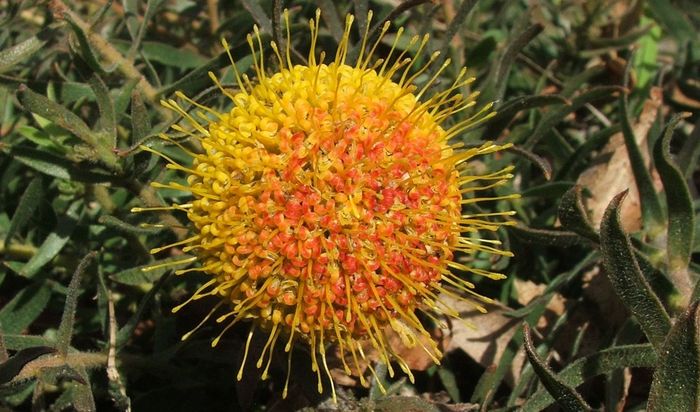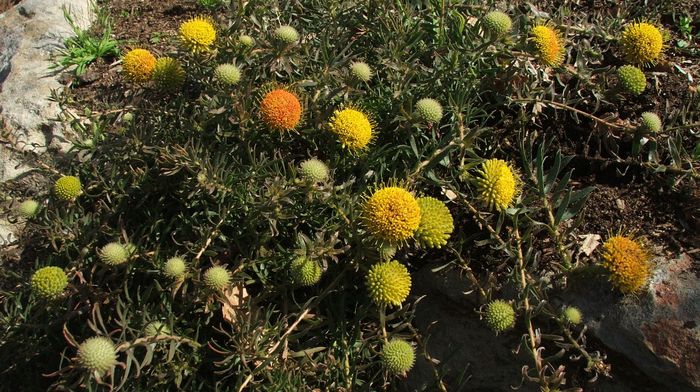Leucospermum prostratum
Leucospermum prostratum (Thunb.) Stapf
Family: Proteaceae
Common names: yellow trailing pincushion
Introduction
Leucospermum prostratum forms a charismatic, trailing carpet with scented, bright yellow, apricot, and then red flowers.

Description
Description
Leucospermum prostratum is a groundcover with long, slender, trailing stems. The stems arise from an underground rootstock and can reach up to 4 m across. The leaves are linear to oblong and point vertically from the horizontal stem. They measure 20–40 mm long and 2–6 mm wide. Leaves are grey-green, sparsely hairy and stalkless with one, pointed, apical tooth at the tip.

The solitary flowerhead is round and measures 20–25 mm across. The style is straight and 12–15 mm long. Sweetly scented flowers are yellow when they open, deepening to apricot and red when mature. The main flowering season occurs from midwinter to early summer (July to December) but odd flowers do appear throughout the year. Seeds are released 1–2 months after flowering.

Conservation Status
Status
Leucospermum prostratum is assessed as vulnerable (VU). This is due to habitat loss mainly caused by invasive alien species, such as the Australian Acacia and Hakea species.
Distribution and habitat
Distribution description
Leucospermum prostratum occurs widely in the southwestern Cape in the following areas: Kogelberg Mountains, Groenland Mountains, Elim Flats and Swartberg Mountains. It grows on sandy flats, 0–500 m above sea level.
Derivation of name and historical aspects
History
The genus Leucospermum contains 50 flowering plants and falls within the Proteaceae or protea family, native to South Africa and North Zimbabwe. Most occur in the winter-rainfall, fynbos region of the Western Cape. The leaves are tough, spirally arranged and leathery, simple, linear to lanceolate with serrated margins or serrated on the apex. The genus Leucospermum was described by Robert Brown in 1810 and means 'white seed', referring to the light-coloured seeds of many species. The specific epithet prostratum means 'to lie down on the ground', referring to its growth form.

Ecology
Ecology
The bright-coloured, sweetly scented flowers are pollinated by bees, beetles and butterflies. Seeds are released within two months after flowering and contain fleshy coverings (elaiosomes) that secrete a chemical substance that attracts ants. The ants carry the seeds to their underground nests and consume only the fleshy skin. After fire the mother plants resprout and the underground seed germinates, when the conditions are favourable.
Uses
Use
Yellow trailing pincushions make a lovely groundcover and need to be planted on a sloping bank or rocky area in the garden, so they can cascade over the rocks.
Growing Leucospermum prostratum
Grow
Propagate Leucospermum prostratum from cuttings or seed. Cuttings will flower and be ready to plant into the garden a year after propagation, whereas seeds are scarce and will take at least two years before being large enough to plant into the garden.
Take cuttings from summer to autumn (December to March). The cuttings should be 40–50 mm long from the current season's growth. Choose vigorous, disease-free material. Dip the semi-hardwood cuttings into a rooting hormone powder and plant into a medium of 50:50 polystyrene and finely milled pinebark. Place in the greenhouse with bottom heat (± 25°C) and intermittent mist. Once the roots are well developed, remove from the intermittent mist and harden off for 2–3 weeks. Transplant into small pots using a well-drained medium made specifically for fynbos plants such as 8 parts bark to 3 parts sand. Ensure the pH is acidic to neutral, 6.5 is ideal. Grow on until ready to plant into the garden.
Sow seeds late summer to autumn (February to April). To initiate germination, seeds need alternating cold night and warm day temperatures of 4–10°C to 15–21°C. Sow the seed into a seed tray and place in a brightly lit and well-ventilated position. Use a well-drained medium consisting of 1 part bark and 2 parts sand; firm down and cover with a layer of sifted sand. Water the seed tray with a fungicide to prevent fungal disease. Germination can be erratic but should begin after 4–5 weeks. Once two true leaves have appeared, pick the seedlings out into small plugs. Place the seedlings in a lightly shaded area with good air circulation and when the seedlings are ± 50 mm tall, transplant them into small pots. When growing on, regularly monitor for disease and fungus and treat as necessary. The best time to plant into the garden is at the start of the rainy season (May to August), so that the plants can be establish before the dry hot, windy summer arrives.
Before planting apply well-rotted compost to the soil. Feed twice a year during spring and autumn with a low dose of slow-release fertilizer. Choose fertilisers that have little or no phosphorous formula. Water early in the morning while the soil is cool to avoid warm, moist conditions, as this creates favourable conditions for fungi and bacteria. Apply a thick layer of mulch to keep the soil cool and moist for a long period. Leucospermum prostratum is best suited to a fynbos garden that has well-drained soil and grows in very sandy acidic soil in nature. A sloping bank or rockery where drainage is very good, is ideal. Plant in full sun in groups of three or more to create a spectacular display. Avoid dense shrubby companion planting that will crowd it out. Good companion plants include Aulax umbellata, Erica haematocodon, Elegia equisetacea and Liparia splendens.
References
- Eliovson, S. 1967. Proteas for pleasure: how to grow and identify them. Howard Timmins, Cape Town.
- Manning, J. & Goldblatt, P. 2012. Plants of the Greater Cape Floristic Region 1: the Core Cape Flora. Strelitzia 29. South African National Biodiversity Institute, Pretoria.
- Plants of southern Africa: an online checklist. http:posa.sanbi.org
- Raimondo, D. et al. 2009. Red list of South African plants. Strelitzia 25. SANBI (South African National Biodiversity Institute), Pretoria.
- Rebelo, T. 1999. West Coast proteas. Field guide to the proteas of the West Coast. Protea Atlas Project, National Botanical Institute, Cape Town.
Credits
Phumza Bavuma & Louise Nurrish
Kirstenbosch National Botanical Garden
October 2014
Plant Attributes:
Plant Type: Shrub
SA Distribution: Western Cape
Soil type: Sandy
Flowering season: Spring, Early Summer, Winter
PH: Acid
Flower colour: Yellow, Orange
Aspect: Full Sun
Gardening skill: Average
Special Features:
Horticultural zones







Rate this article
Article well written and informative
Rate this plant
Is this an interesting plant?
Login to add your Comment
Back to topNot registered yet? Click here to register.